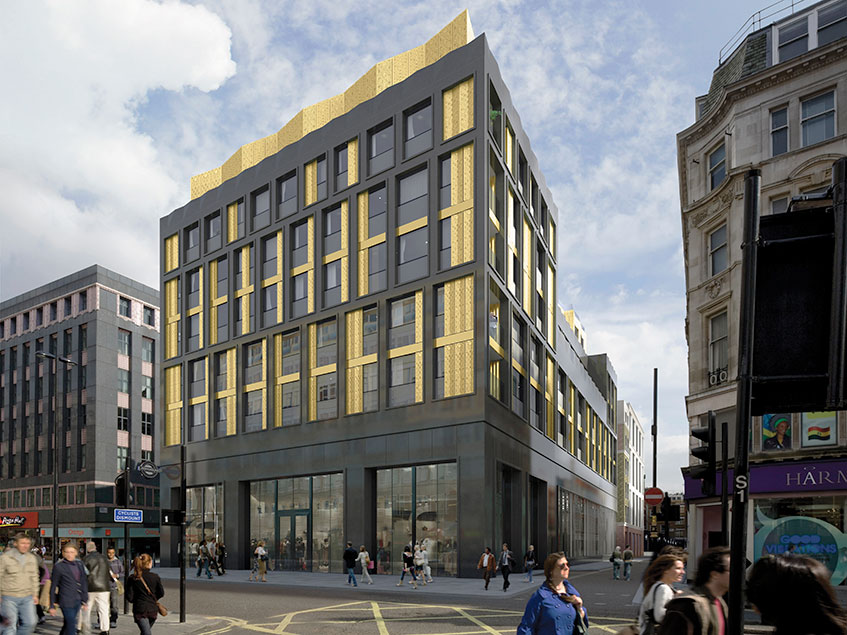London’s residential market has been tough for developers such as Galliard Homes, but founder Stephen Conway believes the bottom has passed
Stephen Conway has called the bottom of London’s housing market. After a flight to the outer boroughs, Galliard Homes has crept back into central London, and its founder and executive chairman is now on the hunt for Zone 1 opportunities.
“London always bounces,” Conway says. “I have never known it not to, and we are just beginning the London bounce.”
The Galliard boss saw the market bottoming late last summer, around the time that he and colleagues were busy locking down the £140m luxury Tottenham Court Road West scheme, WC1.
“It’s always hard to spot the bottom,” Conway acknowledges. But Galliard has experience in picking up prime sites following a downturn. Conway points to his two favourite schemes: the County Hall Apartments, once “the ugliest buildings in Europe”, and Butler’s Wharf, “a derelict series of old spice warehouses”. Galliard bought both following the recession of the early 1990s, subsequently kick-starting the regeneration of London’s South Bank and Shad Thames areas.
Now, the company has its sights set on a new round of dealmaking, including a £100m bid to pick up more space at Nine Elms, Vauxhall.
“People are thinking that we are coming towards the end of Brexit,” Conway says. “Foreign investors are realising that [the capital] is a safe haven to put their money. And London has always been the world’s prime city. Nothing is going to change that.”
And so begins our virtual tour, taking us from Conway’s own neighbourhood of Marylebone out through industrial docklands and back into the comfort of Zone 1, tracing his milestone schemes, evolving pipeline and hit list.
Lack of land
It is a frosty Thursday morning in December when I meet Conway at his local haunt, Fischer’s, an Austrian restaurant on Marylebone High Street. He sips on hot water and lemon and orders a breakfast of piping hot porridge. He is upbeat, waving to other diners he recognises across the restaurant.
Conway has good reason to be chirpy. This day, as voters take to polling stations for the General Election, a Conservative majority is seen as a safe bet. That should encourage growing confidence in central London’s residential market.
The Galliard boss need not look far for inspiration. Just streets away from Fischer’s is the developer’s landmark luxury scheme, the Chilterns, W1, dubbed the “One Hyde Park of Marylebone”, with amenities including a private cinema, a gym and an art gallery advertised as “so private, only a few will ever see it”. In 2014, the penthouse hit the market with a price tag of £25m, or £3,300 per sq ft.
“We would love to build another Chiltern Place,” says an animated Conway. “It is a sensational development. The land just isn’t available.”
That lack of land in central London means competition for sites is stiff in the areas that really excite Conway, such as Marylebone, Soho and Nine Elms.
At TCRW, for example, Galliard beat off rival bids from Native Land and a partnership between Slovakia’s JTRE and Sons & Co, paying £43m for the 0.5-acre site, which sits above a Crossrail station (with a £100m bond in case of damage to the station).
The proposed 92 flats at that site range from £900,000 for a studio to £2.3m for a three-bedroom flat. Galliard has already agreed £55m in off-plan sales of 30 flats, achieving a blended £2,278 per sq ft. Conway estimates that 85% of these sales have come from abroad.
“We could have pitched TCRW closer to £3,000,” he adds. “It would still be significantly cheaper than Centre Point.”
Soaring Asian sales
Galliard makes no secret of its foreign sales strategy. The TCRW launch event was held in Chinatown. The company’s first scheme in Birmingham, the Timber Yard, was in the Chinese Quarter and it has just opened its first Asian office, in Shanghai, with plans for a second in Beijing.
Conway says there has been “phenomenal growth” in Chinese sales and the company plans to set up shop in three or four more Asian cities. “To be honest, we were late on the scene,” he says, acknowledging Berkeley, Barratt and Regal London as first movers. “But we were very early in Hong Kong and Singapore.”
Conway says pre-sales to international buyers are vital for the market, even if such a focus might rile city planners and politicians. “We need foreign sales to make sure these things are being built.”
But rising stamp duty threatens this, and Conway has met with chancellor Sajid Javid to discuss the matter. “He does understand, he’s not a fool,” Conway says. “Time will tell. I think it’s wrong.”
Galliard has a triple-pronged approach to UK sales, targeting foreign international buyers, foreign domestic buyers and local domestic buyers, with a goal to sell around a third off-plan. “We have a reputation for selling off-plan really quickly,” says Conway.
He points to the queues of prospective buyers known to camp in the street outside Galliard offices ahead of sales being launched. “We have a strong marketing effort,” he says. “We were the first ones to really get people queueing.”
The market has been tougher of late, Conway admits. “The difference in the market at the moment is that people are not rushing to buy off-plan. They want to see finished stock, because the perception for the past few years has been that there is not going to be any major increase in prices – and there hasn’t been, in fairness.”
‘Ready to trade’
Conway estimates that prices in the London market have dropped by 20% in the past five years. Amid this cooling, Galliard teamed up with Cain Hoy to invest £1bn in locations in outer London and the South East.
This saw the developer sweep up 15 acres at Southall’s Honey Monster Factory for the 2,000-home Quayside Quarter and join forces with Catalyst in Wimbledon and Aviva at Cantium Retail Park on Old Kent Road, SE1, as well as committing £500m to Birmingham with Apsley House Capital.
As inner London picks up, Conway estimates that the outer boroughs are lagging a year behind. “London moves out in waves, so the outer boroughs are just about reaching their bottom. Now we are waiting for those areas to turn.”
Not all will, however. Although the promise of Crossrail has opened up the city, a flurry of developments around station hubs has created massive oversupply, most notably at Old Kent Road.
“There is a lot of supply in Old Kent Road coming through. That will mean it will probably be below what I consider to be its base value,” Conway says. “What we are seeing with those [schemes] is they take a long time to actually work through the system, particularly now that you can’t sell 300 flats off-plan for delivery in three years.”
Aviva and Galliard have had conversations with developers in the area about an exit at Cantium Retail Park, which received consent for 1,113 homes in up to 48 storeys last year, and Conway says that at the right price they would sell.
“We are always ready to trade,” he adds. “If we can’t make substantially more money by developing it, we’d sell the site.”
He goes on: “We have all the frontage in front of the Berkeley Homes site. Tony [Pidgley, Berkeley chairman] keeps teasing us about making an offer to buy it, but he is just dancing around the dance floor.”
The bounce and BTR
So what will Galliard be looking at buying if, as Conway predicts, London now bounces back? While Old Kent Road becomes less desirable, Conway perks up on the topic of Nine Elms Parkside in Vauxhall, SW8. The site is a former Royal Mail sorting office, which Royal Mail has been selling plot by plot.
“Everyone thought Nine Elms was going to be a massive oversupply [of homes], but it is not,” Conway says. “The location has taken over and the prices have dropped. We think Nine Elms will sell for sub-£1,000 a square foot.”
Conway says Galliard will bid £100m for the last three sites, E, F and G, comprising 794 homes. The company paid £25m for plot C, with consent for 262 flats, which it forward-sold to Mitsubishi Estate and its fund manager, Europa Capital.
Competition for such opportunities will be fierce. As build-to-rent players flock to the remaining resi, Galliard will undoubtedly find itself bidding against a number of these funds.
Galliard is no stranger to BTR builds as it diversifies its exit strategies. Following success in micro-flats via office-to-resi permitted development, it is even trying its hand at co-living with its first scheme in Hounslow in partnership with Princeton Investments.
Compared with BTR funds, Conway says Galliard is an “uncomplicated purchaser”. He adds: “We pay on the nose, and that makes it far simpler for the vendor to deal with.” Unlike many recent new entrants to Zone 1, it also boasts its own delivery arm and a newly bulked up team of around 600 employees.
This could give Galliard an edge when it comes to fighting for sites in Zone 1, as well as mooted expansions in Salford and Leeds, and growing interest in Liverpool. As chairman, Conway will steer this acquisition strategy, sniffing out sites for growth and staying ahead of the curve in this next rebound.
“My grandfather used to say to me, ‘Remember, one thousand geniuses can’t sell what one lunatic buys,’ and that really is true in the property business,” he says. “It is all about what you buy. If you have bought right, then you can sell it.”
Conway on the housing crisis
Conway argues that the UK’s housing crisis is in fact an affordability crisis – one that the government must solve.
“We need to build more housing that people can afford to buy or rent, and that’s in the government’s hands,” he says, adding that the government should tap public land to offer accommodation for people who cannot afford private market homes.
“There is a crisis, where people can’t afford to get on the ladder and are living in inadequate flats. If the government wants to, it can solve that crisis, but there is too much bureaucracy, the planning system is ridiculous and there is too much nimbyism.”
In the absence of public spending, the bulk of affordable housing delivery relies on private sector section 106 contributions. Conway says that as London local authorities move to levels of 40% affordable housing on schemes, “they risk killing the golden goose and slowing everything down”.
Galliard’s much-anticipated acquisition of the £300m Morrison’s development at Camden Goods Yard was ultimately scuppered by unworkable deadlines in the section 106 agreement and the threat of increasing social housing requirements.
Sandwiched between Primrose Hill and Crossrail, the site is in a great location, Conway says, but “it was impossible to buy”.
“If you can deal with all the headaches, sorting out the 106 and building the new supermarket, with Crossrail having the right to enter the site – and you’ve got to stop work so they can access it – if you can deal with all of that, it will be a wonderful development for someone.”
For any developer unable to meet the deadlines, the council reserves the right to revisit the section 106 agreement and increase the social housing requirement. Was striking a deal a challenge, then? “I’d say it was f***ing impossible,” responds Conway.
After a year of negotiations, Galliard stepped away from the project. Hot on its heels, Tony Pidgley’s Berkeley swooped on the site, paying £120m for the development, comprising £85m for the land and £35m to redevelop the supermarket.
To send feedback, e-mail emma.rosser@egi.co.uk or tweet @EmmaARosser or @estatesgazette



















